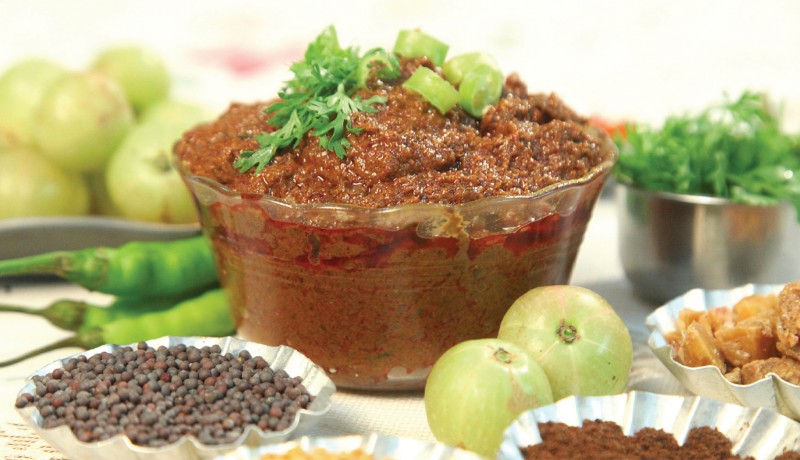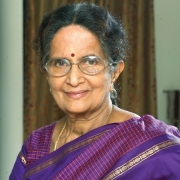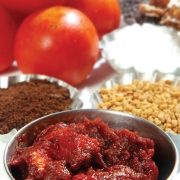
Columns

A series by Pratibha Jain about silvers who believe nurturing the body and mind is the key to joy.
Featuring Kameswari Kunapuli from Hyderabad
Beautiful and gracious. And rivetingly multifaceted, as her friend Sitaji Kolluru, who introduced us, had so aptly described. That’s Kameswari Kunapuli, a classical Carnatic singer and teacher from East Godavari, now residing in Jubilee Hills, Hyderabad. Sitting in her outer living room, we spoke about her family, love for music, and the need to document traditional recipes. I also managed to learn a few Andhra-style recipes. However, as I was getting ready to leave, I spied the interior of her home—and knew instantly that the portrait I had painted of this woman was incomplete, that there was so much more to this enigmatic personality. Intrigued, I asked for a tour around her home, enchanted by the vintage feel and brown hues, the numerous paintings and handcrafted items, many her own creations! In fact, she remains unfazed by her 80 years and continues to try her hand at new skills, new ways of expressing her creativity. The highlight of the impromptu tour, though, was the kitchen with a row of huge pickle jars enough to feed an army; each delicacy handmade, of course. Here are some titbits of our conversation, and some of these cherished recipes….
IN HER OWN WORDS
I was born in Vizag [Visakhapatnam], Andhra Pradesh. Later, we shifted to Rajamundhiri. My father was an advocate and belonged to a cultured background. His family was held in high esteem in his village. I remember my family was always considered well-dressed and up to date. That is my heritage.
FOR THE LOVE OF MUSIC
My elder sister began to learn music when she was in high school. I was an avid listener. Seeing my interest, the teacher Sarasanarsimha Garu started teaching me music as well. I learnt until my 11th standard, after which I became busy with studies, marriage, and then parenthood. When we moved to Karnool, I attended a ladies gathering where someone asked me to sing. There, I sang a favourite of mine, Sri Muthuswami’s kriti, Meenakshi mudamdehi. Showered with praise and compliments, this trigger led to me learning music seriously. So here I am, at 80, a teacher, and happy to sing whenever I can!
PURSUIT OF HAPPINESS
My voice is not young anymore and not good for performances, but I can teach. In the afternoon, middle-aged women come to me to learn music. It is a blessing to teach them because their reason for learning is to perform for the Lord.
PEACEFUL TOGETHERNESS
My husband Shri K V S Suryanarayana was an IAS officer and we often got transferred to other cities. It was a blessing in disguise because it gave me the opportunity to see different places, interact with people from various backgrounds, and broaden my horizons. He passed away in 2008. I see strife in many marriages today because of ego clashes and different priorities but I was truly blessed in this regard. There was never any reason for strife between us. He had deep respect for me and my way of thinking. We shared similar views and enjoyed each other’s company.”
WHERE THE HEART RESIDES
I now live alone and have many interests to keep me busy, such as cooking, stitching, painting, craft making, gardening, and being surrounded by beauty. In fact, I never pursued any one thing seriously because of my diverse interests. I also enjoy attending concerts and visiting friends and relatives. My daughter Atchuta Saraswathi lives in Delhi and my son Satya Kunapuli is in the US. They would like me to live with them but I want to live here as long as I can manage by myself. I have promised them that I will shift into one of their homes the moment I feel I can’t manage. That is our understanding. Along with their spouses and children—I have three grandchildren and one granddaughter-in-law—they all take care of me very well. When I look back, I feel blessed; from my own parents, my in-laws, my children and now my sambandhi, I have been surrounded by remarkable people.
A FLAIR FOR COOKING
My mother was a great cook who could create a meal out of anything. In fact, I had nine paternal aunts who were all good cooks. As the youngest child at home, I never ventured into the kitchen until after my marriage. During my husband’s first posting, I remember hosting a sudden dinner in Bhadrachalam. I managed surprisingly well. My cooking was appreciated, which encouraged me to hone my skills. Whenever I ate something interesting outside, I would ask for the recipe and try recreating it at home. Soon, I was hosting large official dinners.
MEALTIMES
Even though I have staff at home to help, I still cook. After my morning routine of exercise and listening to devotional songs, I decide my meals for the day. Breakfast is oats and fruits. Lunch is usually an Andhra meal—the staff help to chop, while I do the main cooking. And dinner consists of a handful of nuts or fruits and milk. A complete Andhra meal—sampoorna aahara—has steamed rice with pappu (dal), pulusu (gravy), koora (side-dish), pachchadi and curd. I love adding melted ghee in everything. My children and grandson love my Andhra dishes.
KITCHEN TIPS
As you can see in my kitchen, I keep all the provision containers slightly open. I believe closing dabba and bottles tightly will cause overheating, making the contents inside a breeding ground for worms.
PICKLE PASSION
I have always been passionate about pickle-making. Apart from preparing famous Andhra pickles like aavakai and maagai , I prepare pickle with yellow mirchi from Gollaprolu (Andhra), menthikaai and pulihara aavakai with small pieces of mango along with the peel. I still make large quantities of pickles to send to my relatives. Most last for months, some even for years. I make pickles with the help of my staff; I am really lucky to have such good help that has stayed with us wherever we have been transferred. While preparing pickles, one has to take utmost care. The ingredients should be of very good quality and the vessels and storage jars must be clean and dry. In my younger days, I remember that the women of the house would not even touch the pickles before taking a bath. If preserved well, pickles last for years and the taste remains the same, even though some discolouration may happen. By the time the colour changes, the next season comes and the fresh crop is in the market.
TOMATO PASTE
Every year, when tomatoes are in season and cheap, Kameswariji makes this sundried tomato paste. It requires no cooking, yet stays good for a year without refrigeration. She adds a ladle of this paste to sambar, chaaru (rasam), or even soups and side dishes—1 tbsp of this tomato paste is the perfect substitute for one large, fresh tomato.
Ingredients
- Tomatoes: 1 kg; washed and chopped
- Tamarind: ¼ kg; deseeded and broken into small bits
- Salt: ¼ kg
- Turmeric powder: 1 tsp
Method
Mix tomatoes, tamarind and salt. Press them in a jar and keep overnight. The mixture will become watery. Spread this mixture in a large plate and place in the hot sun to dry. Take it back indoors in the evening and bring it back outdoors in the morning. Within 3-4 days, it will be ready. Grind this mixture into a fine paste and preserve in a dry and clean jar. Instead of the lid, cover the mouth of the jar with a cloth so air will pass through and it will not spoil.
Here’s a recipe for tomato pachchadi (chutney) with this paste. Heat 1 tsp oil; add mustard seeds, asafoetida powder and 2 sliced onions. Add 2-4 red chillies or chilli powder and sauté for a while. Switch off the flame. Add ½ tsp roasted and powdered fenugreek seeds. Grind along with ¾ cup of the tomato paste and a fistful of coriander seeds, adding very little water. If you like thinner chutney, you can add more water. Serve as an accompaniment to idlis, dosas or steamed rice.
GOOSEBERRY PASTE
A good source of Vitamin C, gooseberry has many health benefits. This paste can be prepared whenever gooseberries are in season and preserved for months.
Ingredients
- Gooseberries: 1 kg
- Salt: ¼ kg
- Lemons: 4; large
- Turmeric powder: 1 tsp
Method
Wash the gooseberries and wipe them dry. Spread on a clean cloth and leave them for an hour so they dry completely. Pound them lightly and press them down in a jar. Allow to stay in the jar for 2-3 days until the gooseberries turn soft. Transfer to a broad vessel and press the gooseberries lightly to discard the seeds. (You can also cut the gooseberries into small pieces and discard the seeds before putting them into the jar.) Add the salt, turmeric powder and juice of the lemons. Mix well. Transfer to a clean, dry jar and preserve in a cool, dry place. Do not place an airtight lid over it. Instead, cover the mouth of the jar with a cloth so air will pass through and the paste will not spoil.
Note: This gooseberry paste tends to blacken over time. Yet the taste stays good for a year without refrigeration. Once in a while, you can remove the top layer and discard it.
Here’s a recipe for healthy usirikaya pachchadi (gooseberry chutney) with this paste. Pound 2 green chillies and a fistful of coriander leaves; mix with ½ cup gooseberry paste. Add ½ tsp of roasted and powdered fenugreek seeds. Add a garnishing of mustard seeds and asafoetida powder in 1 tsp hot oil. Serve this chutney as an accompaniment to a meal; you can also mix it with steamed rice and garnish with coriander leaves.
Health tip: Every morning, Kameswariji takes a teaspoon of this paste with a teaspoon of honey for its health benefits. However, those with hypertension must avoid it as it has salt. Instead, they can make a gooseberry preserve by grating the gooseberries, adding sugar and cooking them into a jam-like consistency. This can be consumed every morning.
Leftover tip: This gooseberry paste is ideal for scrubbing brass items and making them shine. Whenever the paste turns blackish over time, Kameswariji makes a fresh batch and uses the old paste for polishing her brass items.
Pratibha Jain, an author and translator from Chennai, is the co-author of two award-winning books Cooking at Home with Pedatha and Sukham Ayu. Her area of specialisation is documenting Indian traditions through research, translation and writing
Photos: Anand Kumar Soma Featured in Harmony — Celebrate Age Magazine October 2017
you may also like to read
-
Mental workout
Mukul Sharma tells you how to keep those grey cells ticking Everyone will ultimately lose his or her brain….
-
Helpline
Dr Harshbir Rana answers your queries on personal and social issues related to ageing, elder care and intergenerational relationships ….
-
Off the cuff
Raju Mukherji pays tribute to his first hero, Tenzing Norgay, an exemplary mountaineer Darjeeling, 1955. Dr ‘Pahari’ Guha Mazumdar….
-
Yoga RX
Shameem Akthar shows ways to control debilitating ankle pain through regular practice Ankle pain is so common and prevalent….









